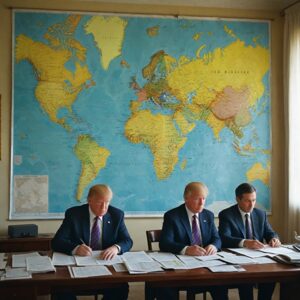Summary
The “state venture capital guidance fund” recently launched by China signifies the nation’s substantial push towards growth in high-tech and emerging industries, such as artificial intelligence (AI), quantum technology, and hydrogen energy storage. Headed by Zheng Shanjie, the fund is planned as a long-term investment, aiming to attract nearly 1 trillion yuan ($138 billion) over a span of 20 years, primarily from local governments and the private sector. The initiative forms a key component of China’s broader strategy to fuel economic growth through technological innovation and establish leadership in frontier industries.
The fund is also poised to catalyze the development of industry-specific applications of AI, demonstrating China’s commitment to harnessing this technology for efficiency, sustainability, and scalable impact across sectors such as healthcare, manufacturing, and energy. Furthermore, it aligns with China’s vision for biotech industry growth, supported by policies to expand capabilities in the biopharmaceutical landscape and promote the transformation of intellectual property into daily applications. In the context of increasing government investment in quantum technology and emerging industries, the fund positions China as a significant player in global science and technology competition.
However, the initiative has not been without its critics. Victor Shih, director of the University of California San Diego’s 21st Century China Center, has raised concerns about the funding mechanisms for these ambitious efforts, suggesting that the reliance on local governments to boost consumption through tax impositions could potentially stifle the very consumption it seeks to increase. Despite such skepticism, the establishment of this fund represents a major step in China’s drive towards global technology and innovation leadership.
Overview of the Fund
China’s newly unveiled “state venture capital guidance fund” is expected to be a significant driving force behind the nation’s growth in high-tech and emerging industries. Headed by Zheng Shanjie, the fund has its focus squarely placed on supporting the development of cutting-edge technologies such as artificial intelligence, quantum technology, and hydrogen energy storage. The fund is planned as a long-term investment initiative, structured as a public-private partnership with a high tolerance for risk.
Over a span of 20 years, the fund is projected to attract nearly 1 trillion yuan ($138 billion) in capital from both local governments and the private sector. Industries that are expected to greatly benefit from this fund include quantum computing, artificial intelligence (AI), semiconductors, and renewable energy.
This fund is a key part of China’s strategy to harness technology for economic growth, complementing other national initiatives aimed at advancing manufacturing, securing supply chains, and achieving technological self-sufficiency. It also reflects China’s broader goal to drive economic growth through technological innovation and leadership in frontier industries.
Moreover, this fund showcases China’s commitment to developing industry-specific applications of AI, which have been successful in driving efficiency, sustainability, and scalable impact in various sectors such as healthcare, manufacturing, and energy.
In addition, the fund aligns with China’s vision for the growth of its biotech industry, which is supported by policies that expand capabilities in the biopharmaceutical landscape and promote the transformation of intellectual property into daily applications. Furthermore, with increasing government spending on quantum technology and emerging industries, China sees this as pivotal in global science and technology competition.
As such, the establishment of this fund is an important step in China’s journey towards the forefront of global technology and innovation, especially in the face of competition and pressure from other technological powers.
The Chinese Government’s Role
The Chinese government plays a critical role in the advancement of emerging technologies, utilizing public-private investment funds known as “guidance funds” to infuse capital into strategic priority sectors like AI and other cutting-edge fields. By 2022, Chinese officials had set up 2,107 guidance funds, with a registered target size of $1.86 trillion. Despite challenges, these guidance funds still hold advantages over traditional industrial policy mechanisms like subsidies and tax incentives.
Recently, China’s top economic officials have committed to the establishment of this state-backed fund to support technological innovation.
Apart from funding, the government has also demonstrated a commitment to boosting consumption as a top policy task, unveiling plans for a “special action plan to boost consumption”. This shift in policy underscores the necessity of reviving the “animal spirits” of China’s private entrepreneurs to drive technological innovation.
Additionally, the Chinese government has shifted its strategy towards incentivizing innovation, with a focus on the biotech sector as a strategic emerging industry. This focus is evident in the ‘14th Five‐Year Plan for Bioeconomy Development’ (2021–2025), which outlines the development goals of China’s bioeconomy in major fields including biomedicine, bio-agriculture, bio-manufacturing, and bio-security.
Impact on Chinese Tech Industry
The implementation of this fund is expected to have a significant impact on the nation’s tech industry, fostering development in cutting-edge fields such as AI, quantum technology, and hydrogen energy storage. With China facing growing pressure from US tech restrictions, the introduction of this fund represents a defiant response, intended to maintain and accelerate the nation’s technological progress. China’s rapid development in microchips, AI large language models, and industrial and humanoid robots serves as testament to its technological capabilities and ambitions.
China’s AI industry, in particular, is slated to provide significant opportunities for foreign companies, bolstered by a strong government commitment, a rapidly expanding market, and policies that encourage private and foreign investment. The Chinese government views AI as a key driver of innovation and is actively promoting its integration across a variety of sectors, including healthcare, education, finance, and urban management.
Furthermore, China’s AI development approach is structured and phased, with ambitious goals set forth in the Next Generation AI Development Plan launched in 2017. This plan aims to establish AI as a core driver of economic transformation by 2025, and to position the country as a global hub for AI innovation by 2030.
This innovative approach to AI and emerging technologies is exemplified by High-Flyer, a Chinese hedge fund that leverages AI in trading markets. The company’s use of AI has triggered a technological arms race among mainland asset managers, which could revolutionize the country’s $10 trillion fund management industry.
Additionally, Chinese policymakers are hopeful that quantum technologies will deliver tangible economic and security benefits, particularly in conjunction with the AI sector. The Chinese government’s “New Generation Artificial Intelligence Development Plan” anticipates that quantum computing could enhance the performance of machine learning algorithms, thereby advancing AI capabilities.
Bio-manufacturing is another emerging industry with significant growth potential, supported by policies such as the “Medical Science and Technology Policy,” the “Bio-Industry Development Eleventh Five-Year Plan,” and “Made in China 2025”.
Selection Criteria for Funding
The Chinese government has established funding mechanisms to support the growth of high-tech startups, especially in fields like AI, quantum technology, and hydrogen energy storage. One of these mechanisms includes subsidies which are distributed through competitions hosted by public-private collaboration platforms such as the Artificial Intelligence Industry Alliance (AIIA).
One major funding avenue is this fund, which is set to concentrate its investments in cutting-edge technological fields. The selection of these particular areas indicates that China’s strategy for fostering innovation is focused on supporting industries that are at the forefront of technological advancement. According to Zheng Shanjie, the head of China’s state economic planner and chairman of the National Development and Reform Commission, this fund is expected to draw in approximately 1 trillion yuan ($138 billion) in capital over 20 years from both local governments and the private sector. This suggests that the selection criteria for this fund may be stringent, emphasizing industries and companies with high potential for technological innovation and economic impact.
Future Goals and Focus Areas of the Fund
The “state venture capital guidance fund” has been established with a primary focus on funding innovation in cutting-edge fields such as artificial intelligence, quantum technology, and hydrogen energy storage . This initiative is a reflection of China’s robust plan to leverage artificial intelligence as a key driver of its economic transformation. The Next Generation AI Development Plan, which was launched in 2017, aims to make the country a global hub for AI innovation by 2030 .
The fund is expected to amass nearly 1 trillion yuan ($138 billion) in capital over a 20-year period from local governments and the private sector . The emphasis on tailoring AI solutions to specific needs showcases an approach other regions could adopt to maximize impact and overcome barriers to adoption .
This fund aligns with China’s ongoing drive to develop new and emerging technologies. This drive has started to present numerous opportunities for foreign investors and companies. Central to this shift is the concept of new quality productive forces (NQPFs), which prioritize the development of cutting-edge technologies, such as AI, robotics, biotechnology, and new energy and materials . This fund, therefore, signifies China’s strategic shift towards an innovation-led growth model, which is projected to enhance global competitiveness and boost economic growth.
Reception and Impact
The reception of China’s high-tech fund for AI and emerging industries has been largely positive. The swift and effective response to key concerns in the private sector, including property rights protection and fair competition, has increased confidence in private enterprises and raised market expectations. This positive response is thought to be highly significant for the stable growth of the Chinese economy .
Despite the ongoing challenges presented by issues such as fragmented data flows, uneven regional capabilities, and a significant talent gap, China’s approach to AI adoption highlights the importance of maintaining interoperability and fostering partnerships. The experience and lessons from China are illustrative, demonstrating how aligning strategy, ecosystem enablers, and industry-specific innovation can help unlock AI’s potential .
However, some skepticism remains. Victor Shih, director of the University of California San Diego’s 21st Century China Center, has expressed concerns regarding how these efforts will be funded. Shih points out that boosting consumption, a priority for Beijing, is largely a mandate that the central government is looking to local governments to fund. He suggests that most provinces would not have the money for these efforts without imposing taxes, which could dampen consumption .


























